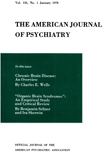Multimedia Teaching of Introductory Psychiatry
Abstract
Preliminary experience and empirical measures suggest that second-year psychiatry can be taught effectively with a multimedia mix of videotaped interviews with patients, an inventory of critical symptoms, a diagnostic chart illustrating clustering of symptoms in the basic diagnosis, and rapid computer analysis and feedback. Traditional methods are also used conjointly. Multimedia teaching provides several channels of informational input and engages the student's interest and motivation by making him an active participant in the learning process.
Access content
To read the fulltext, please use one of the options below to sign in or purchase access.- Personal login
- Institutional Login
- Sign in via OpenAthens
- Register for access
-
Please login/register if you wish to pair your device and check access availability.
Not a subscriber?
PsychiatryOnline subscription options offer access to the DSM-5 library, books, journals, CME, and patient resources. This all-in-one virtual library provides psychiatrists and mental health professionals with key resources for diagnosis, treatment, research, and professional development.
Need more help? PsychiatryOnline Customer Service may be reached by emailing [email protected] or by calling 800-368-5777 (in the U.S.) or 703-907-7322 (outside the U.S.).



